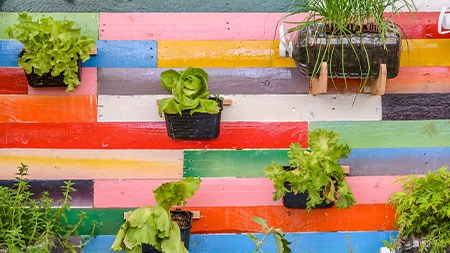Living walls and vertical gardens are a great way to enhance your home. Here are our top vertical garden ideas for creating your own.
With space increasingly becoming a luxury and eco-friendly practises a necessity, vertical gardens, trending just a few years ago in the commercial zone, are becoming more and more popular in home design too. From the simplest row of plants dividing a room, to the most professionally landscaped living wall, the options are endless and exciting: think vertical pallets as a herb or veggie garden, a sophisticated expanse of green-grey succulents, or a frame - a trellis or gate - hung with small plants on display like works on a gallery wall.
Not only are vertical gardens great where there isn’t a lot of space to spare, where there’s an unattractive wall to cover, or for those who simply want to welcome in more green, but having plants at eye-level often brings new appreciation to groundcovers, succulents and small perennials (that we usually need to stoop to see) creating the potential for something completely unique.
Vertical gardens have other advantages too – they promote relaxation, help noise reduction and act as bio-filters, absorbing air-born toxins and releasing oxygen, thereby reducing green house gases in the atmosphere and purifying the air. Exterior green walls also retain rainwater that would otherwise be lost, protect the walls from UV and weather damage, and by providing a layer of insulation around the building, keep a home cooler in summer and warmer in winter, reducing the need for air-conditioning and heating.
With all that going for them, it’s tempting to create one of your own, and why not, be it on a patio, in a courtyard, or indoors.
First off choose a wall that will provide suitable growing conditions if you have particular plants in mind, or tailor your plant choice to suit the wall. The best plants for vertical gardens are dense, compact and low growing, and much as in normal gardening, a wall that gets lots of sun will need sun-loving plants, whereas a shady spot will need a selection of shade loving plants.
There are plenty of ready-made containers and vertical gardening solutions on the market, many of which available in modular form so you can be as inventive as you want using the basic building blocks. You can also design and make your own structure – with many options just a google away.
Before you plant, work out a plant design – you may want to create stripes or a pattern with different coloured plants or use only herbs or vegetables so that you can eat them too.
As with normal gardens you’ll need to work out the watering and feeding schedule, bearing in mind that often a vertical garden has the potential to dry out quickly.
If you’re renting or if your area gets limited sun its worth considering lightweight materials that are easy to move. Pots on wheels with a trellis for climbing plants are a clever way to provide an attractive option or perhaps hang hooks and planters over a wall you can’t drill into.
Position containers and plants where you won’t knock your head as you walk past and avoid hanging plants so high that they are difficult to water and maintain.




